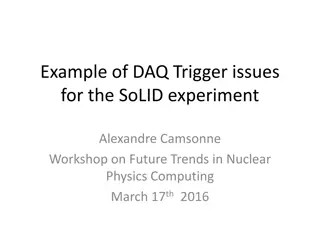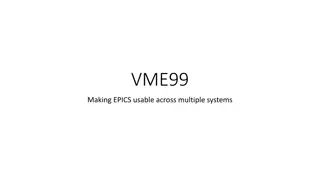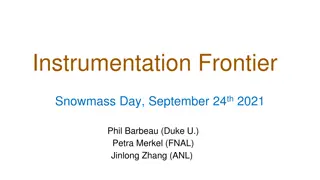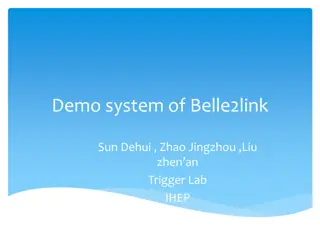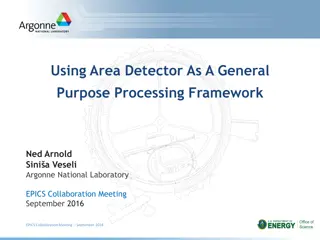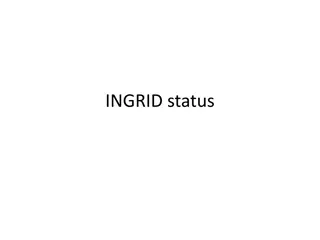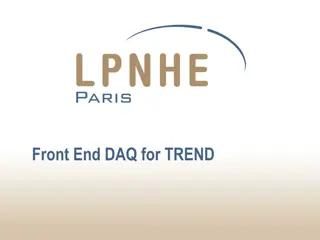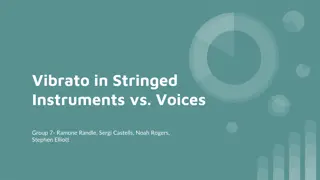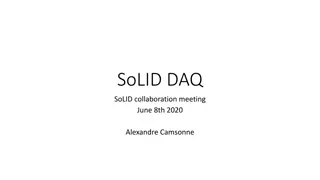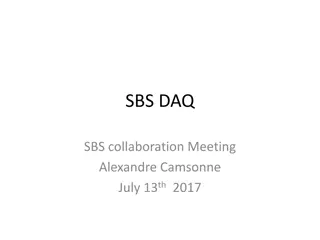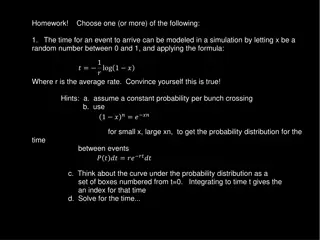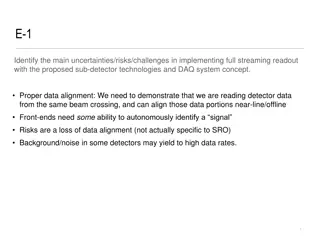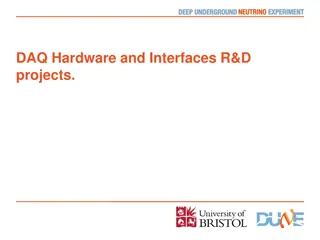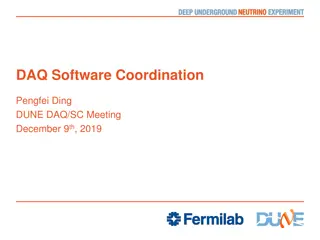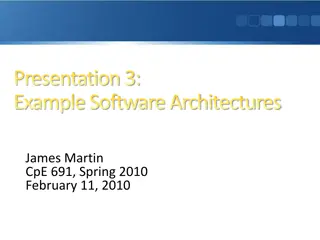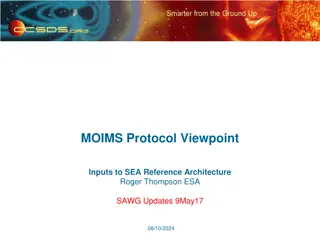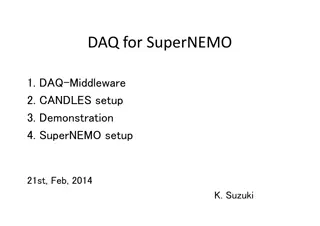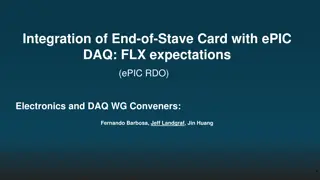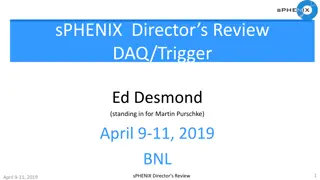Understanding Computer Organization and Architecture
A computer system is a programmable digital electronics device that processes data as per program instructions to provide meaningful output. It comprises hardware and software components, with hardware being the physical parts and software essential for driving the hardware. Computer organization fo
14 views • 71 slides
Decoupled SMO Architecture Overview
Develop flows showing interaction between SMO modules in the context of open-source architecture using OSC, ONAP, and other code. The objective is to align open-source work with O-RAN trends, improve synergy, reduce duplication, and provide feedback to O-RAN discussions. Related work includes Decoup
3 views • 27 slides
Overview of RF Architecture and Waveform Assumptions for NR V2X Intra-Band Operation
In the electronic meeting of 3GPP TSG-RAN-WG4, discussions were held on the RF architecture and waveform assumptions for NR V2X intra-band operation in band n79. Various options and recommendations were presented regarding RF architecture, antenna architecture, and waveform definitions for efficient
1 views • 7 slides
Understanding Computer Architecture and Organization
Computer architecture and organization are fundamental aspects of computing systems. Computer architecture focuses on the functional design and implementation of various computer parts, while computer organization deals with how operational attributes come together to realize the architectural speci
3 views • 40 slides
Common Software Architecture Anti-Patterns
Anti-patterns in software architecture are commonly occurring solutions to problems that lead to negative consequences. These arise due to insufficient knowledge or experience, misuse of design patterns, and lack of attention to evolving project architecture. Examples include Jumble, Stovepipe, Spag
1 views • 7 slides
PowerPC Architecture Overview and Evolution
PowerPC is a RISC instruction set architecture developed by IBM in collaboration with Apple and Motorola in the early 1990s. It is based on IBM's POWER architecture, offering both 32-bit and 64-bit processors popular in embedded systems. The architecture emphasizes a reduced set of pipelined instruc
2 views • 13 slides
Understanding Client-Server Architecture
Client-server architecture is a computing model where a central server hosts and manages resources and services for client computers over a network. There are different types of clients and servers, each with unique characteristics and roles. This architecture offers various advantages and disadvant
3 views • 15 slides
Digital Architecture for Supporting UNICEF's High-Impact Interventions
In an ideal scenario, the digital architecture for children would encompass systems such as Enterprise Architecture, Functional Architecture, and Solution Architecture to support UNICEF's high-impact interventions. It would involve integrated platforms for Health Information Exchange, Supply Chain M
0 views • 19 slides
Understanding DAQ Trigger Issues in SoLID Experiment
Explore DAQ trigger challenges faced in the SoLID experiment through examples, including trigger goals, data readout specifics, and experiment setups. Learn about managing high luminosity, reducing data rates, improving signal quality, and handling bottleneck issues for effective data acquisition. D
0 views • 22 slides
Progress of Network Architecture Work in FG IMT-2020
In the Network Architecture Group led by Namseok Ko, significant progress has been made in defining the IMT-2020 architecture. The work has involved gap analysis, draft recommendations, and setting framework and requirements. Phase 1 focused on identifying 19 architectural gaps, such as demands for
1 views • 11 slides
Closeout Report: Incremental Design Review of EIC Detector Electronics
Closeout report detailing the progress of the Incremental Preliminary Design and Safety Review of the EIC Detector DAQ and Electronics, along with the Final Design Review of Electronics Components for the ePIC Detector. The report includes responses to charge questions, panel reviews, comments, reco
0 views • 23 slides
Challenges and Solutions in Using EPICS for Digital DAQ Systems
Digital DAQ systems based on EPICS face issues with version control, data reading, trigger handling, and GUI consistency. Solutions involve code optimization, improving trigger management, and enhancing GUI design for better user experience.
2 views • 5 slides
Latest Updates on Instrumentation Frontier Activities - September 2021
Instrumentation Frontier activities are picking up pace after the pause in early 2021. Various groups are resuming meetings and workshops, with plans for White Paper kick-off and wrap-up workshops in the coming months. Each subgroup is organizing and categorizing LOIs to drive progress in Quantum Se
0 views • 13 slides
Overview of Belle2Link System
Belle2Link is a unified high-speed link connecting Front-End Electronics, Trigger, and DAQ systems for signal and data transmission. The system features unification in hardware, firmware, electrical isolation, and high-speed transmission rates. The demo system showcases hardware components like COPP
0 views • 21 slides
Implementing Data Acquisition System Using Area Detector as General Processing Framework
The data acquisition system discussed in this content utilizes the Area Detector framework as a versatile processing tool for handling data from various technical subsystems. It covers aspects such as DAQ architecture, high-speed data transfer methods, time-correlated data collection, and usage of A
0 views • 8 slides
Overview of GRANDproto Project Workshop on Autonomous Radio Detection
GRANDproto project workshop held in May 2017 focused on improving autonomous radio detection efficiency for the detection of extensive air showers (EAS). Issues such as detector stability and background rates were discussed, with the goal of establishing radio detection as a reliable method for EAS
1 views • 14 slides
Proposed Way Forward for Service-Oriented Architecture (SOA) in Space Missions
Proposed establishment of a Working Group by the CESG to develop a Service-Oriented Architecture (SOA) framework for space mission operations within the CCSDS. The focus includes identifying services, use cases, architecture definitions, and business cases to enhance CCSDS-wide interoperability and
0 views • 7 slides
Experimental Data Analysis Report
This report covers various aspects of experimental data analysis at the research facility, including the status of INGRID, DAQ, neutrino event rate, beam center stability, event timing, and a general summary with visual representations. The efficiency of data taking, delivery and recording of spills
0 views • 6 slides
Introduction to Y86 Instruction Set Architecture
Y86 Instruction Set Architecture is a simplified pseudo-language based on x86 (IA-32) architecture. It involves implementing the Fetch-Decode-Execute cycle, where instructions are fetched from memory, decoded, and executed. The Y86 ISA offers a simpler set of instructions and formats compared to x86
0 views • 25 slides
Overview of Front-End DAQ for TREND
Cutting-edge Front-End DAQ system featuring components like the Texas Instruments ADS6424 ADC, ALTERA 5CEFA4F23C6N FPGA, Ring Buffer for data management, u-blox Precision Timing GPS module for accurate time stamping, and General Slow Control Architecture for monitoring. The system utilizes Ethernet
0 views • 15 slides
Enhancing Healthcare Data Sharing with Service-Oriented Architectures
This paper explores how Service-Oriented Architectures (SOA) can be integrated with the HL7 Clinical Document Architecture to facilitate the sharing of Summary Care Records between healthcare information systems. It highlights the benefits of a federated architecture based on SOA and coding standard
0 views • 51 slides
Exploring Vibrato in Stringed Instruments and Voices
Vibrato is a key texture in music, captivating Group 7's curiosity. They delve into the distinct characteristics of vibrato, utilizing a range of instruments and technology. Through collaboration, they meet weekly to advance their project on vibrato's impact, with a keen focus on instrumentation, DA
0 views • 10 slides
Exploring Modern Architecture Trends: Expressionism and Bauhaus Movement
Delve into the world of modern architecture trends, focusing on Expressionist architecture in Europe during the early 20th century and the influential Bauhaus movement in Germany. Expressionist architecture emphasized emotional effects through distorted forms inspired by nature, while the Bauhaus sc
0 views • 10 slides
SoLID Collaboration Meeting Summary - June 8th, 2020
Outline of the SoLID collaboration meeting discussing DAQ requirements, trigger rates, infrastructure, and R&D items. Details on detector layouts and triggers for PVDIS and SIDIS, with information on SoLID requirements and associated risks. SoLID DAQ overview based on 12 GeV FADC electronics. Discus
0 views • 35 slides
SuperBigbite Collaboration Meeting Summary on DAQ and Electronics Progress
SuperBigbite collaboration meeting between Alexandre Camsonne and team took place on July 13th, 2017, discussing various topics such as data reduction, network upgrades, DAQ disks, and more. Detailed discussions on expected trigger rates, GEM occupancy, data rates, front tracker layout, and trackers
0 views • 31 slides
Modeling Event Arrival Time in Simulation
Exploring the simulation modeling of event arrival time using a random number formula and understanding the implications through probability distributions and time calculations. Additionally, analyzing small event simulations in STAR DAQ TPC DAQ and discussing data transfer modeling, as well as divi
0 views • 4 slides
Organizing DAQ and Operational Spaces for ProtoDUNE Project
In the context of the ProtoDUNE project, the organization of DAQ and operational spaces is crucial for efficient functioning. The initial installation at CERN faced challenges, prompting the need for remote control capabilities. The setup at SURF requires a thoughtful layout to accommodate key subsy
0 views • 8 slides
Challenges and Common Solutions in Implementing Full Streaming Readout for Sub-Detector Technologies
Implementing full streaming readout with proposed sub-detector technologies and DAQ system concept poses challenges including proper data alignment, risks of data loss, and background noise affecting data rates. The transition point for electronic components from detector-specific to common solution
0 views • 9 slides
Overview of 5G System Architecture and User Plane Functionality
This content showcases various aspects of 5G system architecture, including system handover, non-roaming architecture, service-based architecture, and user plane functionality. It delves into the control plane functions, user plane functions, and core network endpoints of the 5G network. The images
0 views • 49 slides
Overview of Phase 0 Experiment with Straw Trackers at HADES
The Phase 0 Experiment involves including straw trackers in the program before PANDA commences at HADES. The upgrade features two new Forward Straw Tracker stations (STS1, STS2) for testing under experimental conditions. The physics program includes radiative hyperon decays, with STS1/2 tasked for s
0 views • 8 slides
Understanding Client/Server Computing Architecture
Client/Server Computing architecture separates clients and servers over a network, allowing for file sharing, resource allocation, and service requests. Clients initiate services from servers, with transparent server locations and message-passing transactions. Systems with C/S architecture include f
0 views • 18 slides
Advancing DAQ Hardware and Interfaces Through R&D Projects
Explore various hardware-oriented R&D projects including implementing a DPM for SLAC ATCA system, demonstrating software throughput, testing interfaces, examining timing systems, and setting realistic project timescales. Meetings and collaborations are geared towards enhancing R&D efforts and mergin
0 views • 8 slides
Understanding Memory Hierarchy and Different Computer Architecture Styles
Delve into the concepts of memory hierarchy, cache optimizations, RISC architecture, and other architecture styles in embedded computer architecture. Learn about Accumulator and Stack architectures, their characteristics, advantages, and example code implementations. Explore the differences between
0 views • 52 slides
Desired Features of a Software Build System for DUNE DAQ
Discussion on the desired features of a software build system for DUNE DAQ, including creating C++ builds, supporting multiple languages, handling multiple software versions, efficient change management, easy installation processes, modularity, and more. The aim is to streamline the software develop
0 views • 9 slides
Understanding Advanced Computer Architecture in Parallel Computing
Covering topics like Instruction-Set Architecture (ISA), 5-stage pipeline, and Pipelined instructions, this course delves into the intricacies of advanced computer architecture, with a focus on achieving high performance by optimizing data flow to execution units. The course provides insights into t
0 views • 12 slides
Software Architecture Design for Document Filter System: A Case Study
This presentation delves into the software architecture design and implementation of a Document Filter System (DFS) aimed at efficiently finding relevant information. It discusses the architecture's effectiveness in supporting diverse applications, multilingual document searching, complex query func
0 views • 33 slides
MOIMS Protocol Viewpoint for SEA Reference Architecture Updates
This content describes the MOIMS Protocol Viewpoint inputs to the SEA Reference Architecture updates by Roger Thompson from ESA SAWG. It includes details about the graphical conventions, data store elements, organizational domains, network layers, communications protocols, and space communications c
0 views • 21 slides
Overview of Data Acquisition Middleware for SuperNEMO
Data Acquisition Middleware (DAQ) plays a crucial role in managing data flow within the SuperNEMO setup. This includes components like source and sink ports, event managers, loggers, and monitors. The DAQ Middleware state machine controls the configuration, running, and pausing of the DAQ system. Ad
0 views • 12 slides
Integration of End-of-Stave Card with ePIC DAQ: FLX Expectations
In the realm of detector electronics, the integration of the End-of-Stave Card with ePIC DAQ is explored extensively through the FLX expectations set by the Electronics and DAQ Working Group. This integration involves various components such as the Global Timing Unit (GTU), Collider interfaces, Run
0 views • 10 slides
sPHENIX DAQ/Trigger System Overview
The sPHENIX DAQ/Trigger system is the focus of this review, covering the hardware, procurements, technical status, and deliverables of the system. Key components include Data Collection Modules (DCM-II), SubEvent Buffers (SEB), control machines, and global level 1 system. The system aims to achieve
0 views • 21 slides








